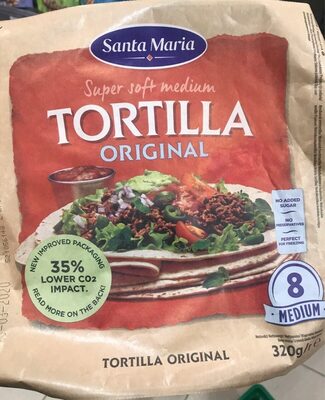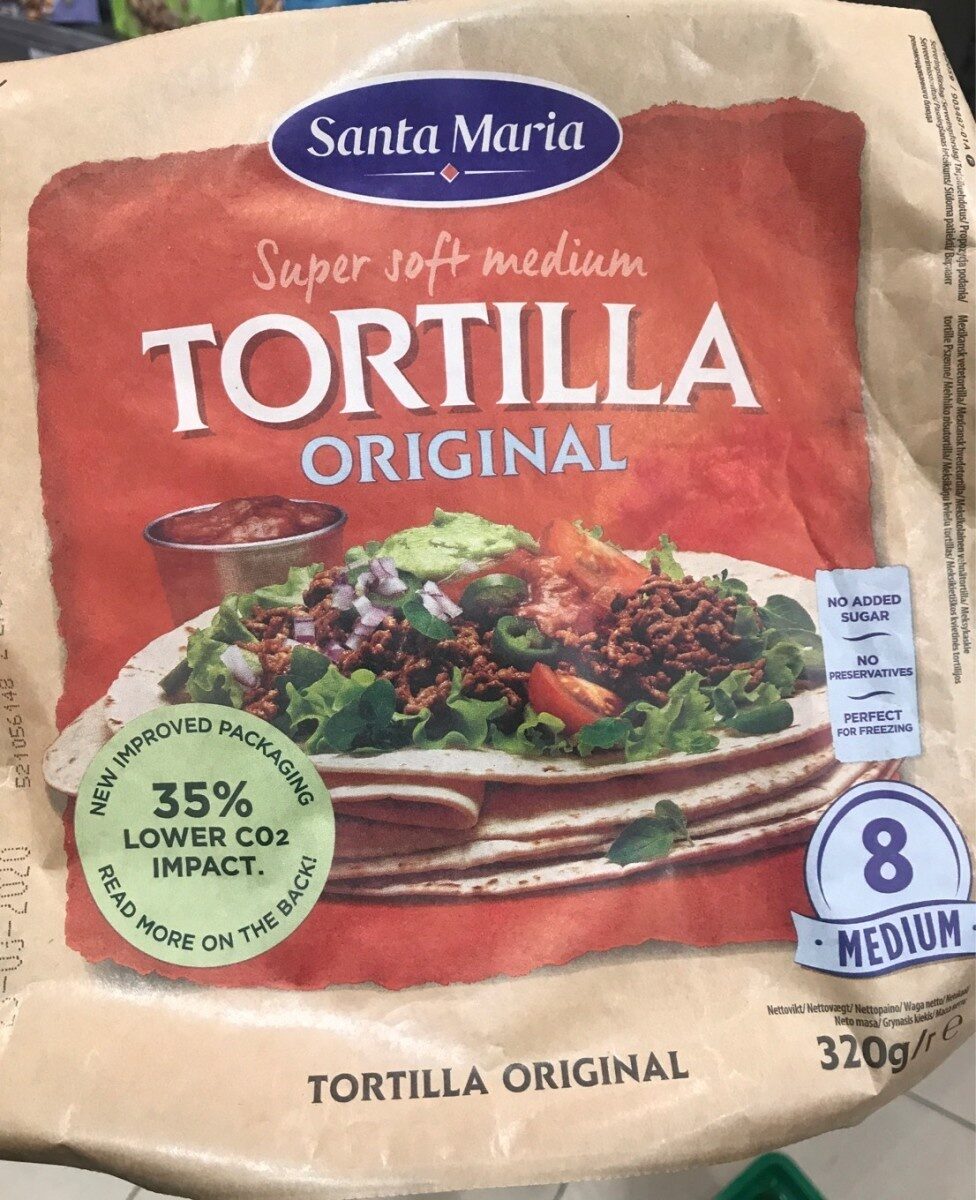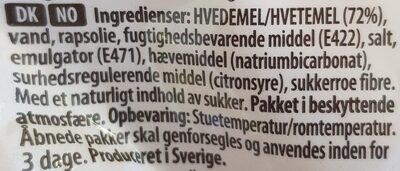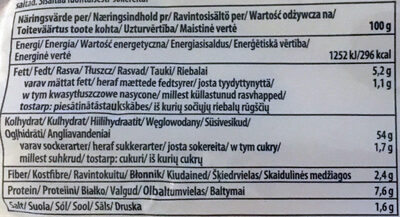Hjelp oss med å gjøre åpenhet om mat til det normale!
Som en ideell organisasjon, er vi avhengige av dine donasjoner for å fortsette å informere forbrukere verden over om hva de spiser.
Matrevolusjonen starter med deg!
Tortilla Orginal - Santa maria - 320g
Tortilla Orginal - Santa maria - 320g
Denne produktsiden er ikke fullstendig. Du kan hjelpe med å ferdigstille den ved å redigere den og legge til mere data fra bildene vi har, eller ved å ta flere bilder i appen for Android eller iPhone/iPad. Takk!
×
Strekkode: 7311311020599 (EAN / EAN-13)
Mengde: 320g
Emballasje: en:Paperi
Merker: Santa maria
Kategorier: en:Plant-based foods and beverages, en:Plant-based foods, en:Cereals and potatoes, en:Breads, en:Flatbreads, en:White breads, en:Wheat breads, en:Wheat flatbreads
Etiketter, sertifiseringer, priser:
Grønt Punkt, en:Ei lisättyä sokeria, en:Säilöntäaineeton
Produksjon- eller behandlingssteder: Sweden
Sporbarhetskode: FSC-C068028
Samsvarer med dine preferanser
Helse
Ingredienser
-
14 ingredienser
HVETEMEL (72%), vann, rapsolie, fuktighetsregulerende middel (E422), salt, emulgator (E471), hevemiddel (natriumbikarbonat), surhetsregulerende middel (sitronsyre), sukkerørfibre. Med et naturlig innhold av sukker. Pakket i beskyttende atmosfære.Allergener: Gluten
Matprosessering
-
Ultrabearbeidede matvarer
Elementer som indikerer at produkter er i en:4 - Ultra processed food and drink products-gruppen:
- Tilsetningsstoff: E422 - Glycerol
- Tilsetningsstoff: E471 - Mono- og diglyserider av fettsyrer
- Ingrediens: Emulgeringsmiddel
Matvarer er inndelt i 4 grupper i henhold til bearbeidingsgraden:
- Ubearbeidet eller minimalt bearbeidet mat
- Bearbeidede kulinariske ingredienser
- Bearbeidet mat
- Ultrabearbeidede matvarer
Bestemmelsen av gruppa er basert på kategorien til produktet og på ingrediensene den inneholder.
Tilsetningsstoffer
-
E330 - Sitronsyre
Citric acid: Citric acid is a weak organic acid that has the chemical formula C6H8O7. It occurs naturally in citrus fruits. In biochemistry, it is an intermediate in the citric acid cycle, which occurs in the metabolism of all aerobic organisms. More than a million tons of citric acid are manufactured every year. It is used widely as an acidifier, as a flavoring and chelating agent.A citrate is a derivative of citric acid; that is, the salts, esters, and the polyatomic anion found in solution. An example of the former, a salt is trisodium citrate; an ester is triethyl citrate. When part of a salt, the formula of the citrate ion is written as C6H5O3−7 or C3H5O-COO-3−3.Kilde: Wikipedia (Engelsk)
-
E422 - Glycerol
Glycerol: Glycerol -; also called glycerine or glycerin; see spelling differences- is a simple polyol compound. It is a colorless, odorless, viscous liquid that is sweet-tasting and non-toxic. The glycerol backbone is found in all lipids known as triglycerides. It is widely used in the food industry as a sweetener and humectant and in pharmaceutical formulations. Glycerol has three hydroxyl groups that are responsible for its solubility in water and its hygroscopic nature.Kilde: Wikipedia (Engelsk)
-
E471 - Mono- og diglyserider av fettsyrer
Mono- and diglycerides of fatty acids: Mono- and diglycerides of fatty acids -E471- refers to a food additive composed of diglycerides and monoglycerides which is used as an emulsifier. This mixture is also sometimes referred to as partial glycerides.Kilde: Wikipedia (Engelsk)
-
E500 - Natriumkarbonater
Sodium carbonate: Sodium carbonate, Na2CO3, -also known as washing soda, soda ash and soda crystals, and in the monohydrate form as crystal carbonate- is the water-soluble sodium salt of carbonic acid. It most commonly occurs as a crystalline decahydrate, which readily effloresces to form a white powder, the monohydrate. Pure sodium carbonate is a white, odorless powder that is hygroscopic -absorbs moisture from the air-. It has a strongly alkaline taste, and forms a moderately basic solution in water. Sodium carbonate is well known domestically for its everyday use as a water softener. Historically it was extracted from the ashes of plants growing in sodium-rich soils, such as vegetation from the Middle East, kelp from Scotland and seaweed from Spain. Because the ashes of these sodium-rich plants were noticeably different from ashes of timber -used to create potash-, they became known as "soda ash". It is synthetically produced in large quantities from salt -sodium chloride- and limestone by a method known as the Solvay process. The manufacture of glass is one of the most important uses of sodium carbonate. Sodium carbonate acts as a flux for silica, lowering the melting point of the mixture to something achievable without special materials. This "soda glass" is mildly water-soluble, so some calcium carbonate is added to the melt mixture to make the glass produced insoluble. This type of glass is known as soda lime glass: "soda" for the sodium carbonate and "lime" for the calcium carbonate. Soda lime glass has been the most common form of glass for centuries. Sodium carbonate is also used as a relatively strong base in various settings. For example, it is used as a pH regulator to maintain stable alkaline conditions necessary for the action of the majority of photographic film developing agents. It acts as an alkali because when dissolved in water, it dissociates into the weak acid: carbonic acid and the strong alkali: sodium hydroxide. This gives sodium carbonate in solution the ability to attack metals such as aluminium with the release of hydrogen gas.It is a common additive in swimming pools used to raise the pH which can be lowered by chlorine tablets and other additives which contain acids. In cooking, it is sometimes used in place of sodium hydroxide for lyeing, especially with German pretzels and lye rolls. These dishes are treated with a solution of an alkaline substance to change the pH of the surface of the food and improve browning. In taxidermy, sodium carbonate added to boiling water will remove flesh from the bones of animal carcasses for trophy mounting or educational display. In chemistry, it is often used as an electrolyte. Electrolytes are usually salt-based, and sodium carbonate acts as a very good conductor in the process of electrolysis. In addition, unlike chloride ions, which form chlorine gas, carbonate ions are not corrosive to the anodes. It is also used as a primary standard for acid-base titrations because it is solid and air-stable, making it easy to weigh accurately.Kilde: Wikipedia (Engelsk)
-
E500ii - Natriumbikarbonat
Sodium carbonate: Sodium carbonate, Na2CO3, -also known as washing soda, soda ash and soda crystals, and in the monohydrate form as crystal carbonate- is the water-soluble sodium salt of carbonic acid. It most commonly occurs as a crystalline decahydrate, which readily effloresces to form a white powder, the monohydrate. Pure sodium carbonate is a white, odorless powder that is hygroscopic -absorbs moisture from the air-. It has a strongly alkaline taste, and forms a moderately basic solution in water. Sodium carbonate is well known domestically for its everyday use as a water softener. Historically it was extracted from the ashes of plants growing in sodium-rich soils, such as vegetation from the Middle East, kelp from Scotland and seaweed from Spain. Because the ashes of these sodium-rich plants were noticeably different from ashes of timber -used to create potash-, they became known as "soda ash". It is synthetically produced in large quantities from salt -sodium chloride- and limestone by a method known as the Solvay process. The manufacture of glass is one of the most important uses of sodium carbonate. Sodium carbonate acts as a flux for silica, lowering the melting point of the mixture to something achievable without special materials. This "soda glass" is mildly water-soluble, so some calcium carbonate is added to the melt mixture to make the glass produced insoluble. This type of glass is known as soda lime glass: "soda" for the sodium carbonate and "lime" for the calcium carbonate. Soda lime glass has been the most common form of glass for centuries. Sodium carbonate is also used as a relatively strong base in various settings. For example, it is used as a pH regulator to maintain stable alkaline conditions necessary for the action of the majority of photographic film developing agents. It acts as an alkali because when dissolved in water, it dissociates into the weak acid: carbonic acid and the strong alkali: sodium hydroxide. This gives sodium carbonate in solution the ability to attack metals such as aluminium with the release of hydrogen gas.It is a common additive in swimming pools used to raise the pH which can be lowered by chlorine tablets and other additives which contain acids. In cooking, it is sometimes used in place of sodium hydroxide for lyeing, especially with German pretzels and lye rolls. These dishes are treated with a solution of an alkaline substance to change the pH of the surface of the food and improve browning. In taxidermy, sodium carbonate added to boiling water will remove flesh from the bones of animal carcasses for trophy mounting or educational display. In chemistry, it is often used as an electrolyte. Electrolytes are usually salt-based, and sodium carbonate acts as a very good conductor in the process of electrolysis. In addition, unlike chloride ions, which form chlorine gas, carbonate ions are not corrosive to the anodes. It is also used as a primary standard for acid-base titrations because it is solid and air-stable, making it easy to weigh accurately.Kilde: Wikipedia (Engelsk)
Analyse av ingredienser:
-
en:May contain palm oil
Ingredienser som kan inneholde palmeolje: E471
-
en:Vegan status unknown
Ugjenkjente ingredienser: Rapsolie, Fuktighetsregulerende-middel, Sukkerørfibre, Med-et-naturlig-innhold-av-sukkerNoen ingredienser kunne ikke gjenkjennes.
Vi trenger din hjelp!
Du kan hjelpe oss med å gjenkjenne flere ingredienser og bedre analysere ingredienslista for dette produktet og andre ved å:
- Rediger denne produktsiden for å korrigere skrivefeil i ingredienslista, og/eller for å fjerne ingredienser på andre språk og setninger som ikke er knyttet til ingrediensene.
- Legg inn nye oppføringer, synonymer eller oversettelser til våre flerspråklige ingredienslister, ingrediensbearbeidingsmetoder, og etiketter.
Bli med i kanalen #ingredients på vårt Slack-samtalested og/eller lære om ingrediensanalyse på wikien vår, hvis du ønsker å hjelpe til. Tusen takk!
-
en:Vegetarian status unknown
Ugjenkjente ingredienser: Rapsolie, Fuktighetsregulerende-middel, Sukkerørfibre, Med-et-naturlig-innhold-av-sukkerNoen ingredienser kunne ikke gjenkjennes.
Vi trenger din hjelp!
Du kan hjelpe oss med å gjenkjenne flere ingredienser og bedre analysere ingredienslista for dette produktet og andre ved å:
- Rediger denne produktsiden for å korrigere skrivefeil i ingredienslista, og/eller for å fjerne ingredienser på andre språk og setninger som ikke er knyttet til ingrediensene.
- Legg inn nye oppføringer, synonymer eller oversettelser til våre flerspråklige ingredienslister, ingrediensbearbeidingsmetoder, og etiketter.
Bli med i kanalen #ingredients på vårt Slack-samtalested og/eller lære om ingrediensanalyse på wikien vår, hvis du ønsker å hjelpe til. Tusen takk!
-
Detaljer fra analysen av ingrediensene
Vi trenger din hjelp!
Noen ingredienser kunne ikke gjenkjennes.
Vi trenger din hjelp!
Du kan hjelpe oss med å gjenkjenne flere ingredienser og bedre analysere ingredienslista for dette produktet og andre ved å:
- Rediger denne produktsiden for å korrigere skrivefeil i ingredienslista, og/eller for å fjerne ingredienser på andre språk og setninger som ikke er knyttet til ingrediensene.
- Legg inn nye oppføringer, synonymer eller oversettelser til våre flerspråklige ingredienslister, ingrediensbearbeidingsmetoder, og etiketter.
Bli med i kanalen #ingredients på vårt Slack-samtalested og/eller lære om ingrediensanalyse på wikien vår, hvis du ønsker å hjelpe til. Tusen takk!
nb: HVETEMEL 72%, vann, rapsolie, fuktighetsregulerende middel (e422), salt, emulgator (e471), hevemiddel (natriumbikarbonat), surhetsregulerende middel (sitronsyre), sukkerørfibre, Med et naturlig innhold av sukker- HVETEMEL -> en:wheat-flour - vegan: yes - vegetarian: yes - ciqual_proxy_food_code: 9410 - percent_min: 72 - percent: 72 - percent_max: 72
- vann -> en:water - vegan: yes - vegetarian: yes - ciqual_food_code: 18066 - percent_min: 3.11111111111111 - percent_max: 28
- rapsolie -> nb:rapsolie - percent_min: 0 - percent_max: 24.8888888888889
- fuktighetsregulerende middel -> nb:fuktighetsregulerende-middel - percent_min: 0 - percent_max: 12.4444444444444
- e422 -> en:e422 - vegan: maybe - vegetarian: maybe - percent_min: 0 - percent_max: 12.4444444444444
- salt -> en:salt - vegan: yes - vegetarian: yes - ciqual_food_code: 11058 - percent_min: 0 - percent_max: 8.2962962962963
- emulgator -> en:emulsifier - percent_min: 0 - percent_max: 6.22222222222222
- e471 -> en:e471 - vegan: maybe - vegetarian: maybe - from_palm_oil: maybe - percent_min: 0 - percent_max: 6.22222222222222
- hevemiddel -> en:raising-agent - percent_min: 0 - percent_max: 4.97777777777778
- natriumbikarbonat -> en:e500ii - vegan: yes - vegetarian: yes - percent_min: 0 - percent_max: 4.97777777777778
- surhetsregulerende middel -> en:acidity-regulator - percent_min: 0 - percent_max: 4.14814814814815
- sitronsyre -> en:e330 - vegan: yes - vegetarian: yes - percent_min: 0 - percent_max: 4.14814814814815
- sukkerørfibre -> nb:sukkerørfibre - percent_min: 0 - percent_max: 3.55555555555555
- Med et naturlig innhold av sukker -> nb:med-et-naturlig-innhold-av-sukker - percent_min: 0 - percent_max: 3.11111111111111
Ernæring
-
Gjennomsnittlig ernæringskvalitet
⚠ ️Advarsel: mengden frukt, grønnsaker og nøtter er ikke spesifisert på etiketten, den ble anslått utfra ingredienslista: 0Dette produktet regnes ikke som en drikke under beregningen av Nutri-Score.
Positive poeng: 2
- Protein: 5 / 5 (verdi: 8.3, avrundet verdi: 8.3)
- Fiber: 2 / 5 (verdi: 2.5, avrundet verdi: 2.5)
- Frukt, grønnsaker, nøtter, og raps/valnøtt/olivenoljer: 0 / 5 (verdi: 0, avrundet verdi: 0)
Negative poeng: 11
- Energi: 3 / 10 (verdi: 1280, avrundet verdi: 1280)
- Sukker: 0 / 10 (verdi: 2, avrundet verdi: 2)
- Mettet fett: 1 / 10 (verdi: 1.1, avrundet verdi: 1.1)
- Natrium: 7 / 10 (verdi: 640, avrundet verdi: 640)
Poengene for proteiner telles ikke fordi de negative poengene er større eller lik 11.
Ernæringsverdi: (11 - 2)
Nutri-Score:
-
Næringsnivåer
-
Fett i moderat mengde (4.9%)
Fint å vite- Et høyt inntak av fett, spesielt mettet fett, kan øke kolesterolet, som øker risikoen for hjertesjukdommer.
Anbefaling: Reduser inntaket av fett og mettet fett- Velg produkter med lavere fett- og mettet fettinnhold.
-
Mettet fett i liten kvantitet (1.1%)
Fint å vite- Et høyt inntak av fett, spesielt mettet fett, kan øke kolesterolet, som øker risikoen for hjertesjukdommer.
Anbefaling: Reduser inntaket av fett og mettet fett- Velg produkter med lavere fett- og mettet fettinnhold.
-
Sukkerarter i liten kvantitet (2%)
Fint å vite- Et høyt inntak av sukker kan føre til økning i vekt og tannråte. Det øker også risikoen for diabetes type 2 og hjerte- og karsjukdommer.
Anbefaling: Begrens inntaket av sukker og sukkerholdige drikker- Sukkerholdige drikker (som brus, fruktdrikker, og fruktjuicer og nektar) burde begrenses så mye som mulig (ikke mer enn 1 glass om dagen).
- Velg produkter med lavt sukkerinnhold og reduser inntaket av produkter med tilsatt sukker.
-
Salt i høy kvantitet (1.6%)
Fint å vite- Et høyt inntak av salt (eller sodium) kan føre til et økt blodtrykk, som kan føre til høyere risiko for hjertesjukdom og slag.
- Mange folk har høyt blodtrykk uten å vite det, siden det ofte ikke er noen symptomer.
- De fleste inntar for mye salt (i gjennomsnitt 9 til 12 gram per dag), cirka det dobbelte av den anbefalte høyeste mengden av inntak.
Anbefaling: Begrens inntaket av salt og saltet mat- Reduser mengden salt som brukes ved matlaging, og ikke salt igjen ved bordet.
- Begrens inntaket av salte snacks og velg produkter med lavere saltinnhold.
-
-
Ernæringsinnhold
Ernæringsinnhold Som solgt
for 100 g / 100 mlSom solgt
per porsjon (100.0 g (100.0 g))Sammenlignet med: en:White breads Energi 1 280 kj
(302 kcal)1 277 kj
(302 kcal)+3 % Fett 4,9 g 4,9 g −40 % Mettet fett 1,1 g 1,1 g −50 % Karbohydrat 55 g 55 g +19 % Sukkerarter 2 g 2 g −66 % Kostfiber 2,5 g 2,5 g Protein 8,3 g 8,3 g +21 % Salt 1,6 g 1,6 g +87 % Fruits‚ vegetables‚ nuts and rapeseed‚ walnut and olive oils (estimate from ingredients list analysis) 0 % 0 %
Miljø
-
Eco-Score B - Low environmental impact
Eco-Scoren er en eksperimentell poengsum som oppsummerer miljøavtrykket til matprodukter.→ Eco-Scoren ble opprinnelig utviklet for Frankrike og den blir nå utvidet til andre europeiske land. Eco-Score-formelen er i stadig endring og forbedres jevnlig for å gjøre den mer presis og bedre egnet til hvert land.Livssyklusanalyse
-
Gjennomsnittlig avtrykk for produkter i samme kategori: A (Score: 93/100)
Kategori: Wheat tortilla wrap, to be filled
Kategori: Wheat tortilla wrap, to be filled
- PEF-miljøscore: 0.16 (jo lavere poengsum, jo lavere avtrykk)
- inkludert innvirkning på klimaendringer: 1.13 kg CO2-ekv./kg produkt
Trinn Påvirkning Landbruk
42.7 %Bearbeiding
35.0 %Emballasje
15.0 %Transport
6.8 %Distribusjon
0.5 %Forbruk
0.0 %
Fordeler og ulemper
-
Mangler ingrediensopprinnelsesinformasjon
Ulempe: -5
⚠ ️ Opprinnelsen til ingrediensene til produktet er ikke angitt.
Hvis det er indikert på emballasjen, kan du redigere produktsiden og legge det til.
Hvis du er produsenten av produktet, kan du sende oss informasjon gjennom vår gratis plattform for produsenter.
-
Mangler emballasjeinformasjon for dette produktet
Ulempe: -15
⚠ ️ Informasjonen om emballasjen til dette produktet er ikke fylt ut.⚠ ️ For en mer presis beregning av Eco-Scoren, kan du modifisere produktsiden og legge dem til.
Hvis du er produsenten av produktet, kan du sende oss informasjon gjennom vår gratis plattform for produsenter.
Eco-Score for dette produktet
-
Avtrykk for dette produktet: B (Score: 73/100)
Produkt: Tortilla Orginal - Santa maria - 320g
Livssyklusanalysescore: 93
Sum av fordeler og ulemper: -20
Endelig poengsum: 73/100
-
Carbon footprint
-
Likt som å kjøre 0.6 km i en bensinbil
113 g CO² per 100g produkt
Karbonutslippstallet kommer fra ADEME's Agribalyse database, for kategorien: Wheat tortilla wrap, to be filled (Kilde: Ademe Agribalyse Database)
Trinn Påvirkning Landbruk
35.5 %Bearbeiding
27.7 %Emballasje
24.8 %Transport
11.6 %Distribusjon
0.4 %Forbruk
0.0 %
Emballasje
-
Mangler emballasjeinformasjon for dette produktet
⚠ ️ Informasjonen om emballasjen til dette produktet er ikke fylt ut.Ta et bilde av resirkuleringsinformasjonen Ta et bilde av resirkuleringsinformasjonen
Transport
-
Opprinnelsen til ingredienser
Mangler ingrediensopprinnelsesinformasjon
⚠ ️ Opprinnelsen til ingrediensene til produktet er ikke angitt.
Hvis det er indikert på emballasjen, kan du redigere produktsiden og legge det til.
Hvis du er produsenten av produktet, kan du sende oss informasjon gjennom vår gratis plattform for produsenter.Legg til opprinnelsen til ingrediensene i dette produktet Legg til opprinnelsen til ingrediensene i dette produktet
Report a problem
-
Incomplete or incorrect information?
Category, labels, ingredients, allergens, nutritional information, photos etc.
If the information does not match the information on the packaging, please complete or correct it. Open Food Facts is a collaborative database, and every contribution is useful for all.
Datakilder
Produkt lagt til av kiliweb
Siste redigering av produktsiden den av macrofactor.
Produktside også redigert av foodless, immun, inf, moon-rabbit, mvainola, nassiba, odinh, openfoodfacts-contributors, prepperapp, quentinbrd, queuinghistories, roboto-app, yuka.Um9BWVNhSmFwOGtMcS9jRjF3dlMrY3hRNmNTR1Z6T2NNN1VVSWc9PQ.













